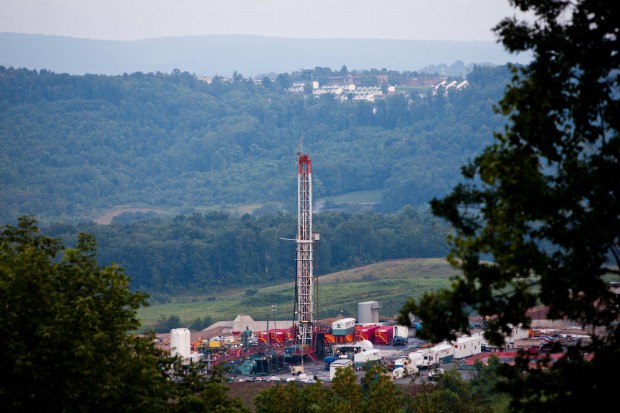New study links gas drilling to migraines, fatigue and chronic sinus symptoms
-
Susan Phillips

A new study by Johns Hopkins Bloomberg School of Public Health shows an association between heavy gas drilling and migraines, fatigue and nasal symptoms.
A new study published today in the peer-reviewed journal Environmental Health Perspectives shows an association between living near heavy gas drilling activity and common ailments like chronic nasal and sinus symptoms, severe fatigue, and migraines. The report is part of an ongoing collaboration between the Geisinger Health System and Johns Hopkins Bloomberg School of Public Health.
“These three health conditions can have debilitating impacts on people’s lives,” says Aaron W. Tustin, MD, MPH, a resident physician in the Department of Environmental Health Sciences at the Bloomberg School. “In addition, they cost the health care system a lot of money. Our data suggest these symptoms are associated with proximity to the fracking industry.”
The researchers used health surveys gathered from almost 8,000 patients of Geisinger Health System from 40 counties in north and central Pennsylvania and divided the results into two groups. One group reported no symptoms, while the other reported two or more. This data was then matched with the proximity of respondents to heavy gas drilling activity. The researchers used gas drilling locations and intensity of shale gas production provided by the Pennsylvania Department of Environmental Protection, the Department of Conservation and Natural Resources, and satellite imagery from the group SkyTruth.
Sara Rasmussen, a Ph.D. candidate at the Bloomberg School and an author on the paper, says the three health symptoms were selected because they are common, can result in large economic costs, and are potentially linked to environmental factors such as chemical toxicity, odors and stress. The report suggests an association, but the data does not reveal a direct cause.
“We’re not able to point a finger at a specific pathway,” said Rasmussen. “The study does contribute to a growing body of papers that show an association between unconventional natural gas development and health outcomes. It’s important for legislators to take this into account when deciding how to move forward with this industry.”
Dr. Bernard Goldstein, emeritus dean of environmental and occupational health at the University of Pittsburgh Schools of Health Sciences, says he wishes a study like this had been conducted sooner.
“These are the kind of studies that should have been done five, six, seven years ago when we had a great opportunity to do before and after,” he told StateImpact. “We’re sort of playing catch up now.”
Goldstein did not contribute to the study.
The Marcellus Shale Advisory Commission under former Governor Tom Corbett recommended this type of study, but it was never conducted. Goldstein says the American Petroleum Institute did request proposals from researchers for these types of health studies, but ended up not funding them.
“We’ve had a long wait for these studies,” he said.
The American Petroleum Institute says it’s committed to protecting the safety of the communities where drilling takes place and working with regulators.
“Safety is a core value for the industry, and the men and women in our industry are committed to protecting the communities in which they operate,” spokesman Reid Porter wrote in an email. “Our industry is one of the most heavily regulated industries in the country, and we have a long history of setting high standards, and working with federal, state and local governments to ensure the highest level of safety possible.”
The researchers found that of the 7,785 survey participants, 23 percent reported suffering from migraines, 25 percent experienced severe fatigue and 24 percent had chronic rhino sinusitis (CRS), which is at least three months of nasal and sinus symptoms.
Rasmussen says those who lived closest to heavy drilling activity were 49 percent more likely to have CRS and migraines together compared to those who do not live near intense natural gas production. That same population was 88 percent more likely to suffer from CRS and heavy fatigue, 95 percent more likely to have migraines and fatigue, and 84 percent more likely to experience all three symptoms.
Rasmussen says more research is needed to determine whether there is a direct causal link with shale gas drilling, and what that cause would be. She says it could be a number of things including, odors, stress, noise, bright lights, or increased truck traffic.
Dr. Goldstein says if the Pennsylvania Department of Public Health had conducted these types of health surveys years ago, the state would be in a better position to protect resident’s health by pinpointing the exact cause.
“That’s the kind of thing I’m looking for,” Goldstein said, “and I can’t get it (from this data set) and it’s frustrating because these are the kind of studies that should have been done by now.”
The research was funded by the National Institutes of Health’s National Institute of Allergy and Infectious Diseases and the National Institute of Environmental Health Sciences, along with the Robert Wood Johnson Foundation, and the National Science Foundation.
















